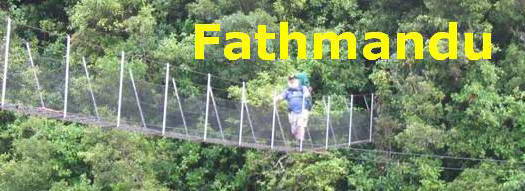
Many thanks for permission to use graphics from their software and toposheets |
 |
|
7 July 2007 Ridge Rd Trackpage 2 So far the track has been pleasant walking, but at this point it begins a slightly steeper descent, and the surface litter has been washed away and replaced by what is in effect a shallow streambed over clay for the next kilometre or thereabouts. Ferns, mainly kiokio and punga are luxuriant.
It is an ongoing jest of mine that the Maori name is to be preferred in most instances, because it changes less often than the scientific name. But this most common of New Zealand ferns has at least 7 Maori names as well as going by some 15 different botanical names over the years. At present it goes as Blechnum novae-zelandiae, the New Zealand blechnum.
One of the features of this track is the succession of swampy puddles that straddle the path carrying water across. The recent rain has not improved matters, but generally trampers have improvised walkarounds. Alice goes straight through today.
We carry on gently downhill
A small lancewood (horoeka) pushes its way through a bed of Blechnum fraseri, the minature tree fern
We pass through a section of track where the clay has a considerable coarse gravelly component. I'd be interested to learn more of the history of Long Rd/Ridge Rd
The bush cover is extremely dense, but not tall. I notice, as we descend, a gradual shift towards moss and lichens that are not present in the more scrubby bush near Anawhata. A small-leaved rata - Metrosideros perforata - makes its way up a trunk. Most of the rata on this track is the next leaf-size up. M. diffusa. I take a moment or two to appreciate the leaf pattern against the play of different coloured bark.
A couple of young tawari present a most unusual colour - a kind of mushroom bronze. Dead punga fronds provide most of the litter just here - a distinctive dark russet brown.
Nearby are more young rewarewa. Maybe it's partly the light but they have a slight bronze cast (??) as well.
Hardly anywhere along here can you look at the litter without seeing a host of small seedlings. Here, totara, rimu and lancewood are all within inches of each other.
I mentioned before that mahoe was relatively scarce along this track, and as far as I can see it's general place in the scheme of things has been occupied by Alseuosmia macrophylla, karapapa.
We move along. The clay surface is just slippery enough to warrant watching every step placement. As soon as I relax, and start to stride along, a foot will disappear sideways amid a flailing of hiking poles. No sitdowns this trip, fortunately, but I need to pay attention.
I think this bush lawyer is Rubus schmidelioides, the longer, narrower leaves, and the grouping of several leaflets together being the criteria. R. australis has heart shaped leaves and R. cissoides somewhere between the two. However, R. cissoides does have a highly variable leaf shape. If I can remember to look next time, it has yellow prickles, where R. schmidelioides has reddish prickles. Come to think of it, recalling some photos I took in the South Island, I think the serrations on R. schmidelioides leaves are much coarser....
Parts of the track are scoured quite deeply by running water
Water is pouring across the track all along here.
|
|